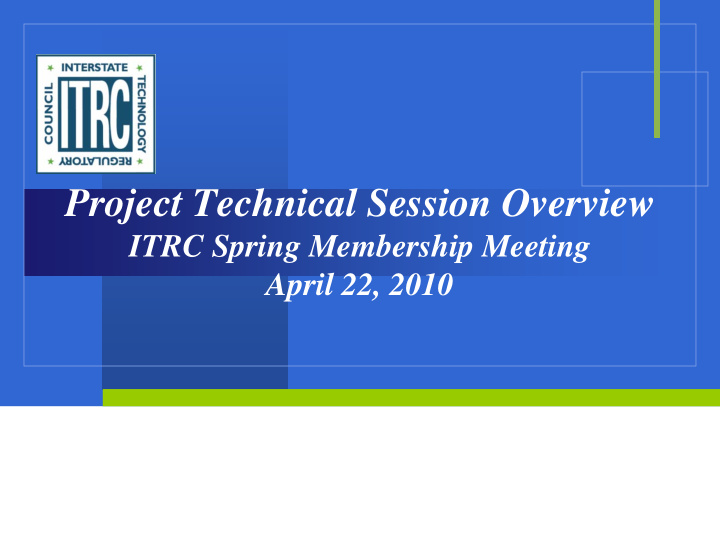



Project Technical Session Overview ITRC Spring Membership Meeting April 22, 2010 Click add sub-title
Purpose of Sessions � Understand technical focus of five current projects � Interact and provide feedback on challenges and solutions being explored by teams � Identify implementation issues early
Biofuels PROBLEM � Post-production release scenarios and releases of biofuels to surface water, soil and groundwater differ from those of conventional fuels due to their physical, chemical and biological properties. � Once released into the environment, the fate and transport of biofuels differs from that of conventional fuels, with implications for investigation, characterization and remediation strategies and methods. APPLICABLE REGULATORY PROGRAMS � Renewable Fuels Standards mandates – federal and some states - for biofuels use. � State regulatory programs, such as storage tanks; NPDES programs for discharges from remediation systems, and groundwater cleanup programs. DRAFT TEAM SOLUTIONS � Provide a framework for evaluation of release scenarios and releases of current and future biofuels. � Current knowledge of fate and transport of biofuels in the environment and appropriate site investigation, characterization, and remediation strategies of biofuels releases. � Case studies of E95 and B100 releases. OPEN ISSUES � Incorporation of a multi-media assessment framework and recommendations for biofuels releases. � Considerations regarding how much detail to go into for currently available biofuels and blends (such as E10) while still insuring that the document is written to provide enough guidance for future biofuels.
Green and Sustainable Remediation PROBLEM � Current remediation approaches at contaminated sites do not consider green or sustainable approaches � A need to provide guidance and training to state regulators and other stakeholders on implementing green and sustainable methods in the remediation programs APPLICABLE REGULATORY PROGRAMS � CERCLA, RCRA, UST, Brownfields, Voluntary Cleanups and other regulatory requirements � Groundwater, Air Quality, Solid Waste, Hazardous waste programs areas, etc DRAFT TEAM SOLUTIONS � An overview document on current GSR practices that are available for practitioners � A technical-regulatory guidance document that meets the needs of state regulators in making better management decisions regarding GSR practices � A compilation of metrics and tools to evaluate how green and/or sustainable are these remedies OPEN ISSUES � How to keep the focus specific to the state regulators needs? � How to help the stakeholders to make better decisions among all the options that are available � Educating/training environmental remediation practitioners for GSR processes
Incremental Sampling Methodology PROBLEM � Little information and inconsistent understanding of Incremental Sampling Methodology (ISM) � Limited regulatory guidance on ISM � Inappropriate application of ISM could inhibit use of a valuable tool APPLICABLE REGULATORY PROGRAMS � CERCLA RCRA State Sites Petroleum Sites DOD DOE Brownfield Sites DRAFT TEAM SOLUTIONS � Build on existing guidance and develop web-based Tech-Reg document that evaluates ISM � Identify ISM principles, critical elements, advantages, potential drawbacks and regulatory challenges � Provide guidelines for evaluating ISM and present case studies to demonstrate proper ISM application � Conduct IBT to clearly communicate ISM principles and illustrate methodology through case studies OPEN ISSUES � Communicate ISM concept to multi-disciplinary stakeholders and address states policies and regulations � Use of ISM mean concentration for decisions by Federal/State programs � How and when ISM can be applied, and when ISM should not be used � ISM results: True mean; all of the time, most of the time? A 95%UCL with just 3 ISM results? � Integration of discrete and ISM results � Assess the critical nature of sample variability
In-Situ Stabilization PROBLEM � The use of in situ solidification and stabilization (S/S) technologies is hampered by the lack of uniform performance parameters, measurements, and criteria to evaluate the success of S/S implementation and information regarding long term monitoring which led to inconsistencies and lack of standard approaches from one EPA region to another and from state to state, resulting in case-by-case development of acceptable performance measurements and criteria. APPLICABLE REGULATORY PROGRAMS � Federal programs, including CERCLA and RCRA � State programs, including Brownfield and petroleum sites DRAFT TEAM SOLUTIONS � Provide guidance on establishing and selecting performance parameters, measurements, and criteria through the planning, treatability testing, design, full-scale implementation, and post-construction phases of a typical on-site S/S project. � Present considerations for long-term monitoring to aide practitioners and regulators in determining site- specific approaches that provide relevant reliable measures of remedy success. OPEN ISSUES � I s development of guidance on performance specifications too narrow of a topic? � Development of written case studies, including actual versus hypothetical case studies � Scope for addressing stakeholder and regulatory concerns in the document.
Permeable Reactive Barriers PROBLEM � PRBs have been installed throughout the country but advances in PRB approaches need to reach the regulatory and technical communities. � These include use of non-iron reactive materials such as biowalls, improved installation methods, and longevity information of older PRBs APPLICABLE REGULATORY PROGRAMS � Comprehensive Environmental Response, Cleanup, and Liability Act (CERCLA) � Resource Conservation and Recovery Act (RCRA) � RCRA-equivalent state programs and state water-quality programs (vary from state to state) � Any regulatory program that performs or oversees groundwater remediation DRAFT TEAM SOLUTIONS � Provide guidance to help regulators and environmental practitioners evaluate and implement plans for barrier design, placement and reactive materials for PRBs addressing groundwater remediation OPEN ISSUES � Lack of data and literature for some of the more novel reactive media such as carbon/iron compounds � Communicate to regulators and the technical community that PRBs are green and sustainable
Recommend
More recommend